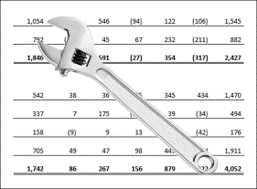 Over the years we gain weight. Our metabolism slows down, such as the number of our inventory cycles, or the time it takes us to respond to changes in market conditions. We eat more, such as adding product or service lines and increasing our spending on items that are not necessarily necessary. We don’t keep the proportion between what comes in, and what goes out.
Over the years we gain weight. Our metabolism slows down, such as the number of our inventory cycles, or the time it takes us to respond to changes in market conditions. We eat more, such as adding product or service lines and increasing our spending on items that are not necessarily necessary. We don’t keep the proportion between what comes in, and what goes out.
We shouldn’t wait until there is a need in a bariatric procedure, i.e., a crisis that is threatening the firm’s health. A better way is to maintain healthy nutrition, and reasonable physical fitness, i.e., “eating” and burning, although we really don’t like that focus our business, improve its cost structure, and improve its competitivity.
There is usually much that can be done to improve operational efficiency, but before doing that you better consider the following: If you got a Strategic challenge, operational efficiencies would not provide you with the desired cure. That will only postpone the potential crisis. That’s right, operational efficiencies will give you some time, but will not prevent an upcoming crisis that stems from a strategic misfit. That can also be rephrased positively: Operational efficiencies can potentially generate the cash required for taking care of your strategic weakness – but you must take advantage of that time window and opportunity.
Given that your financial position is currently solid, and that even if margins are not as great as they used to be, you may want to reexamine your product-market positions. There may be product or service lines that keep you above the water, while others pull down. Regarding the later ones, the question is whether anything can be done to improve their margins. Whether the answer is yes, or no, starting with these. If not – maybe such positions should be withdrawn. If yes – do not wait with that. It won’t get better unless you fix it. For example, prices should sometimes be increased; suppliers may need to be revisited or replaced, the workforce dealing with such lines may be excessive, etc. There is also a possibility within a given product category there are specific products that pull you up, and others that pull you down. Such a situation is described as a “product proliferation”. That is another expression of our gaining weight over the years, resulted from tireless efforts to innovate and come up with new, successful products (a recommended read: Too much of a good thing? Product proliferation and organizational failure).
After dealing with low-performing product-market positions, or with specific products within such positions, there may be less operational efficiencies to address. Why? Because the earlier course of action also had some operational implications. For example, if a given product line was withdrawn – issues related to that line’s suppliers, or the workforce, or facilities – are no longer relevant. If any specific products were eliminated – optimizing the inventory levels of such products is no longer relevant. Overheads related to such cases may also have already been addressed. It all ends up in numbers.
The cash saved can now be used for good purposes, such further investments in marketing and selling strong (core) product or service categories, or market segments, or developing new ones. That’s right, that may plant the seeds of our next round of realignment. But that’s the course of corporate life.
The opinions expressed on this website are not suitable for all business circumstances.
